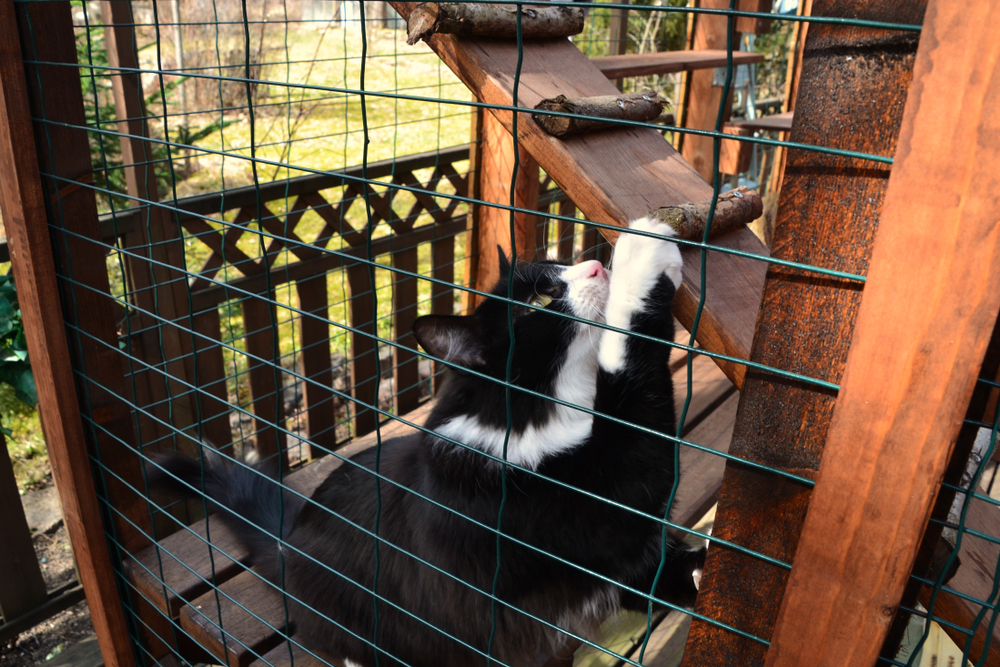Dogs can enjoy a safe, fenced yard, but animal welfare experts recommend that cats and rabbits remain indoors where they are safe from predators, accidental escapes, and extreme weather. Some people keep rabbits in outdoor hutches, but this is reasonable only in extremely mild climates, and hutches are usually inadequate in size. Housing small pets indoors keeps them safer, but they miss the fun and fulfillment they could have from access to the outdoors. This is why we love catios and rabbitats! Catios and rabbitats are fully enclosed, safe outdoor spaces that allow our cat and rabbit friends to have enriching outdoor experiences.
Catio and Rabbitat Construction
We recommend these features for a successful catio or rabbitat:
- Right-sized spaces. If you’re planning a catio for multiple cats, include 18 square feet of floor space per cat. This is a minimum, so exceed this size if possible. For rabbits, two properly paired, bonded rabbits can share a rabbitat. Ensure that each rabbit can easily take “three hops” minimum within the enclosure. Generally, this is six feet of room. A couple of rabbits should not have smaller than a 6-x-6-foot rabbitat space, and larger is always preferred.
- Sturdy exterior enclosure. A typical screen such as that used on a screened porch is not strong enough to keep predators out and pets in. Screens can be damaged by UV light, normal wear and tear, and weather. If you have a screened porch and wish to retrofit it as a catio or rabbitat, side it with “Petscreen,” a special tough style of screen. If you’re building a catio from scratch, you could use a material that is safe but more visually open than a screen, such as 1-x-1-inch or 1.5-x-1.5-inch welded wire mesh, firmly attached to support posts. We recommend omitting doors from the catio or rabbitat to the yard, to prevent escapes. Access to the catio or rabbitat is safest from the house.
- Protection from the elements. Assuming the enclosure has safe sides and a top, think next about its comfort. Catios and rabbitats should be protected from rain, snow, and severe weather, as well as hot summer sun. Sun protection is especially important for rabbits because they cannot tolerate extreme heat. When possible, we like to place catios and rabbitats on the south sides of buildings where they benefit from warming, low winter sun on cold days, and can be shaded from high summer sun. East sides can be pleasant as well. Provide animal-safe shade plantings around the catio/rabbitat so the structure is more comfortable in summer.
- Cleanable floor surface. The most practical surface for the floor of your catio or rabbitat is a hard, impervious product such as concrete or floor tile. We do not recommend wood floors because they’re not as easy to keep clean. You can find many great tile products, from wood-look tiles to large porcelain tiles with a modern aesthetic.
Tip: Provide a small gap of one-half inch to one inch between the bottom of the screen and the catio/rabbitat floor surface to allow you to mop water to the outside when you’re cleaning.
Catio and Rabbitat Enrichment
- Once your outside space is set up, it is time to furnish it. This is the fun part! Place convenient food, water, and litter areas in the catio or rabbitat. Maximize separation between food and litter. Place hiding boxes, platforms, and toys within the enclosure. Cats can climb high in their catios, but rabbits are safest near the ground. You may place pet-safe plants in your catio and furnish your rabbitat with a daily supply of leafy greens. We love furnishing these outdoor spaces because there is no limit to fun themes. Experiment with accessories to see what your pets like best.
Tip: Move furnishings every couple of days to allow the space to remain fresh, novel, and interesting to your pets.
Resources: If you’re interested in more information about catios, Pinterest is a wellspring. The House Rabbit Society and the Rabbit Welfare Association and Fund are great sources of information about housing and caring for rabbits.
This article was reviewed/edited by board-certified veterinary behaviorist Dr. Kenneth Martin and/or veterinary technician specialist in behavior Debbie Martin, LVT.
Heather E. Lewis, AIA, NCARB, is a principal of Animal Arts, an architectural firm that has exclusively designed animal care facilities, including veterinary hospitals and animal shelters, for more than three decades. She has worked on dozens of projects across the country, both large and small in her 19 years with the firm. Heather is a member of the Fear Free℠ Advisory Board and assisted in creating the Fear Free facility standards for veterinary hospitals. Heather is a regular contributor to various veterinary industry magazines. She has spoken on the design of facilities for the care of animals at dozens of national and regional conferences including Fetch Hospital Design Conferences, the UC Davis Low Stress Animal Handling Conference, and the Humane Society of the United States Animal Care Expo.








